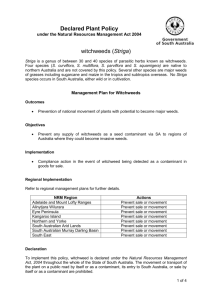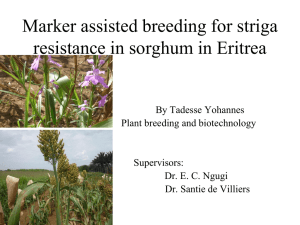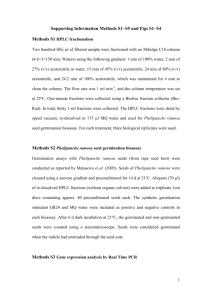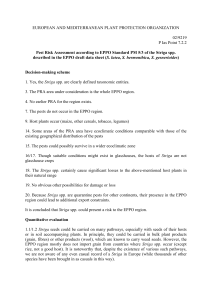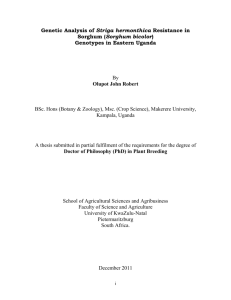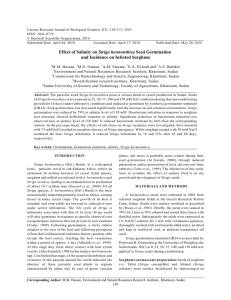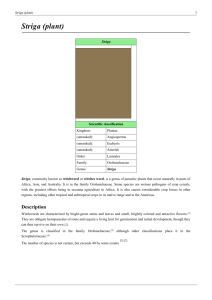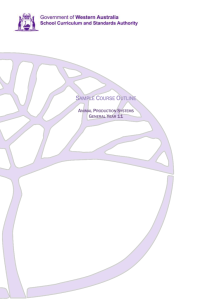Striga spp. - European and Mediterranean Plant Protection
advertisement
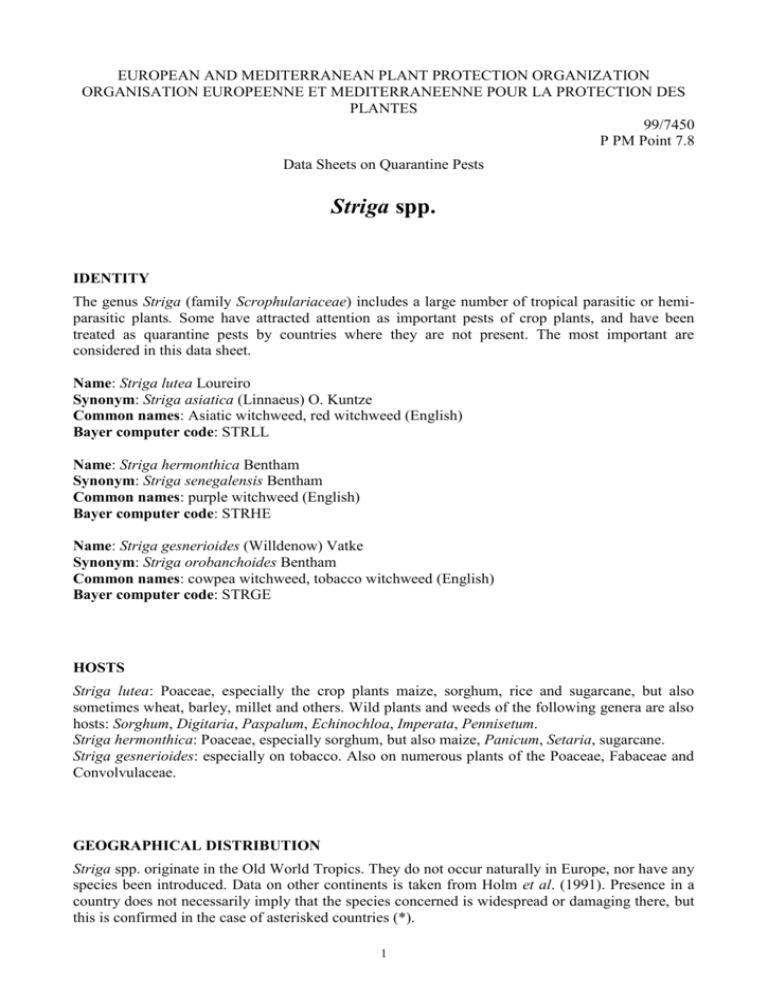
EUROPEAN AND MEDITERRANEAN PLANT PROTECTION ORGANIZATION ORGANISATION EUROPEENNE ET MEDITERRANEENNE POUR LA PROTECTION DES PLANTES 99/7450 P PM Point 7.8 Data Sheets on Quarantine Pests Striga spp. IDENTITY The genus Striga (family Scrophulariaceae) includes a large number of tropical parasitic or hemiparasitic plants. Some have attracted attention as important pests of crop plants, and have been treated as quarantine pests by countries where they are not present. The most important are considered in this data sheet. Name: Striga lutea Loureiro Synonym: Striga asiatica (Linnaeus) O. Kuntze Common names: Asiatic witchweed, red witchweed (English) Bayer computer code: STRLL Name: Striga hermonthica Bentham Synonym: Striga senegalensis Bentham Common names: purple witchweed (English) Bayer computer code: STRHE Name: Striga gesnerioides (Willdenow) Vatke Synonym: Striga orobanchoides Bentham Common names: cowpea witchweed, tobacco witchweed (English) Bayer computer code: STRGE HOSTS Striga lutea: Poaceae, especially the crop plants maize, sorghum, rice and sugarcane, but also sometimes wheat, barley, millet and others. Wild plants and weeds of the following genera are also hosts: Sorghum, Digitaria, Paspalum, Echinochloa, Imperata, Pennisetum. Striga hermonthica: Poaceae, especially sorghum, but also maize, Panicum, Setaria, sugarcane. Striga gesnerioides: especially on tobacco. Also on numerous plants of the Poaceae, Fabaceae and Convolvulaceae. GEOGRAPHICAL DISTRIBUTION Striga spp. originate in the Old World Tropics. They do not occur naturally in Europe, nor have any species been introduced. Data on other continents is taken from Holm et al. (1991). Presence in a country does not necessarily imply that the species concerned is widespread or damaging there, but this is confirmed in the case of asterisked countries (*). 1 Striga lutea Asia: Bangladesh, Cambodia, China, India*, Indonesia, Japan, Malaysia, Myanmar, Pakistan*, Saudi Arabia, Sri Lanka, Thailand, Viet Nam Africa: Cameroon, Côte d'Ivoire, Egypt, Ghana, Guinea, Kenya*, Liberia, Madagascar, Mauritius*, Mozambique, Nigeria, Senegal, Sudan, South Africa*, Tanzania, Uganda*, Zaire, Zambia*, Zimbabwe* North America: USA (North Carolina, South Carolina) Oceania: Australia, New Zealand, Papua New Guinea Striga hermonthica Asia: Cambodia, Saudi Arabia* Africa: Benin, Burkina Faso, Chad, Egypt, Ethiopia, Ghana, Guinea, Kenya, Mali, Mozambique, Niger, Nigeria*, Senegal, South Africa, Sudan*, Tanzania, Uganda*, Zaire, Zimbabwe Striga gesnerioides Asia: Cambodia, India, Japan, Saudi Arabia, Sri Lanka Africa: Egypt, Ethiopia, Guinea, Kenya, Mozambique, Nigeria*, South Africa*, Sudan, Zimbabwe* North America: USA (Florida) Oceania: Australia BIOLOGY Most Striga spp are annual hemi-parasites of monocotyledonous plants (e.g. S. lutea, S. hermonthica). They reproduce by seeds, and a single plant produces as many as 50,000 minute seeds 0.15-0.2 mm in size. These seeds remain dormant in the soil in great numbers. Given suitable conditions of temperature and moisture, they are stimulated to germinate by exudates from the roots of host plants, and the seedlings grow towards them and parasitize them by formation of haustoria. The young plants are entirely parasitic on the host until they emerge, when the shoots develop normal green leaves which sustain further growth. The witchweed remains dependent on the host for mineral substances and water. Some species remain fully parasitic till maturity, and may even hardly emerge above the surface of the soil. The Striga spp. which infect dicotyledonous plants belong in this category (e.g. S. gesnerioides), and resemble members of the related genus Orobanche (familiar root parasites of many plants in Europe). The development cycle typically lasts 90-120 days, and requires a temperature of at least 20°C, but is optimal at 25-30°C . When the conditions for the germination are lacking, the seeds can remain viable in soil for a period up to 20 years. DETECTION AND IDENTIFICATION Morphology A typical witchweed (S. lutea) is an annual plant 15-20 cm tall. The stem is green, square in crosssection and 1-2.5 mm in diameter. The leaves are opposite, each pair borne at right angles to the preceding one. The flowers, variously coloured according to species (yellow or red in S. lutea, bright purple in S. hermonthica, dull pink in S. gesnerioides) and of typical Scrophulariaceous form, are borne in opposite pairs or alternately in a terminal leafy inflorescence. The underground part of 2 the stem is purple, cylindrical, somewhat thicker than the aerial part and 2.5-7.5 cm long. The roots are white and closely attached to the host roots by haustoria. S. hermonthica is a more striking larger plant (up to 60 cm), with large showy flowers. S. gesnerioides, a full parasite, is purplish or brownish in colour, branched, with leaves reduced to scales and the root swollen to a tuber. The seeds are very small and difficult to detect as contaminants of seed lots. Microscopic examination is needed to identify them. MEANS OF MOVEMENT AND DISSEMINATION Under natural conditions, the seeds fall to the soil, which they contaminate in large numbers. Due to their minute size, they are easily dispersed by wind, water, animals etc. Under agricultural conditions, the seeds (and fruit capsules containing them) can contaminate the harvested product, or be moved in soil by machinery or implements. PEST SIGNIFICANCE Economic impact In tropical countries (e.g. in East Africa; Ivens, 1989), the three Striga spp. mentioned occur naturally in wild vegetation. S. lutea and S. hermonthica are important as weeds of grain crops grown by small farmers, especially on dry sandy soils. Grain crops sown on infested land can be parasitized by large numbers of witchweeds (e.g. 50 individuals on a single maize plant). The greatest damage is done in the first month of vegetative growth, when the fully parasitic young witchweeds may not yet have emerged. The host plant wilts, its growth is stunted and it may shrivel and die, or at least produce no grain. Yield losses may reach 40-100 %. S. gesnerioides is especially noted as a pest of tobacco in Zimbabwe, but also attacks cowpea. Control measures Emerged Striga plants can be successfully killed with common herbicides. However, much damage is done by the fully parasitic young plants before emergence, so such herbicide treatments do not necessarily reduce yield losses. The main strategy for control is accordingly to reduce the seed bank of Striga in the soil by stimulating the seeds to germinate in the absence of host plants. This can be achieved by: 1) planting a Poaceous trap crop (susceptible cereal or grass) which is ploughed in a few weeks after sowing before the weeds mature and set seed; 2) sowing crops which stimulate germination, but are not parasitized, for several seasons (e.g. sunflower, groundnut, soybean); 3) treating the soil with ethylene, which simulates the chemical substances which exude from host roots and stimulate germination. In East Africa, the most promising new approach to Striga control is the use of resistant cultivars (e.g. of sorghum). Phytosanitary risk Witchweeds are essentially tropical pests. Their natural distribution is essentially confined to latitudes between 30° N and 30° S. This distribution is determined climatically, (presumably1) by the fact that the seeds are adapted to survive by dormancy during a hot dry season between rainy seasons, and cannot survive the cold moist conditions of a temperate winter. On this basis, tropical countries where these weeds do not occur consider them as quarantine pests (especially in southeast Asia, Latin America, Australia). 1 The EPPO secretariat supposes that there is probably research data to be found on this. 3 No part of the EPPO region is tropical, so at first sight Striga spp. do not present a risk for EPPO countries. However, Striga spp. have been recorded in a number of countries outside the natural range mentioned above, for example, in Egypt, Japan, New Zealand. With currently available information, it is not possible to determine whether these records correspond to established presence, with economic losses, or perhaps just to transient occurrence (of little phytosanitary significance). Egypt is a Mediterranean country and a potential EPPO member, but also extends almost to the tropics in the south, adjoining Sudan where witchweeds are a problem. Though Striga spp. have been recorded in Egypt, it is not clear in what part of the country; Boulos & El-Hadidi (1994), in their "Weed Flora of Egypt", do not mention Striga spp., but refer to several Orobanche spp. as significant parasitic weeds. More significant is the fact that S. lutea has been recorded since the 1950s, and has persisted, in USA, in the states of North and South Carolina. This species is regarded as a quarantine pest for the USA, and the outbreaks are progressively being eradicated. A further consequence of this introduction is that the USA treats all Striga spp. as serious quarantine pests, with the potential to become noxious weeds in that country. In conclusion, it is not possible to state categorically that Striga spp. cannot establish in the EPPO region. There is a possibility that these weeds could survive in areas with a relatively mild dry winter: countries around the Black Sea, in the eastern Mediterranean, in North Africa. Russia includes Striga spp. in general in its list of quarantine pests, citing a risk for the south of the country (and formerly, in documents from the time of the USSR, also for the Caucasus and for Central Asia). A more detailed PRA would be of great interest, concentrating on establishment potential in different climatic zones, and also on the potential to grow and multiply sufficiently to be damaging. Research data from the outbreaks in the Carolinas would be very useful for this 2. It may be added that even transient presence of Striga spp. might have phytosanitary consequences for exports, insofar as these weeds are quarantine pests for the USA, Australia, Latin America and other countries. PHYTOSANITARY MEASURES Consignments originating in countries where the most damaging Striga spp. are present should be free from their seeds (by inspection, or other phytosanitary measures still to be determined). REFERENCES Boulos L & Nabil el-Hadidi M (1994) The weed flora of Egypt. The American University in Cairo Press. Holm LG, Pancho JV, Herberger JP & Plucknett DL (1991) A geographical atlas of world weeds. Krieger Publishing Company, Malabar (US). Ivens GW (1989) East African weeds and their control. Oxford University Press, Nairobi. Savotikov YuF & Smetnik AI (1995) Striga spp. [Manual of the pests, plant diseases and weeds of quarantine significance for the territory of the Russian Federation], p. 125. Arnika, Nizhnii Novgorod (RU) (in Russian). 2 Again, the EPPO Secretariat supposes that this must exist, but has not pursued the question so far. 4

